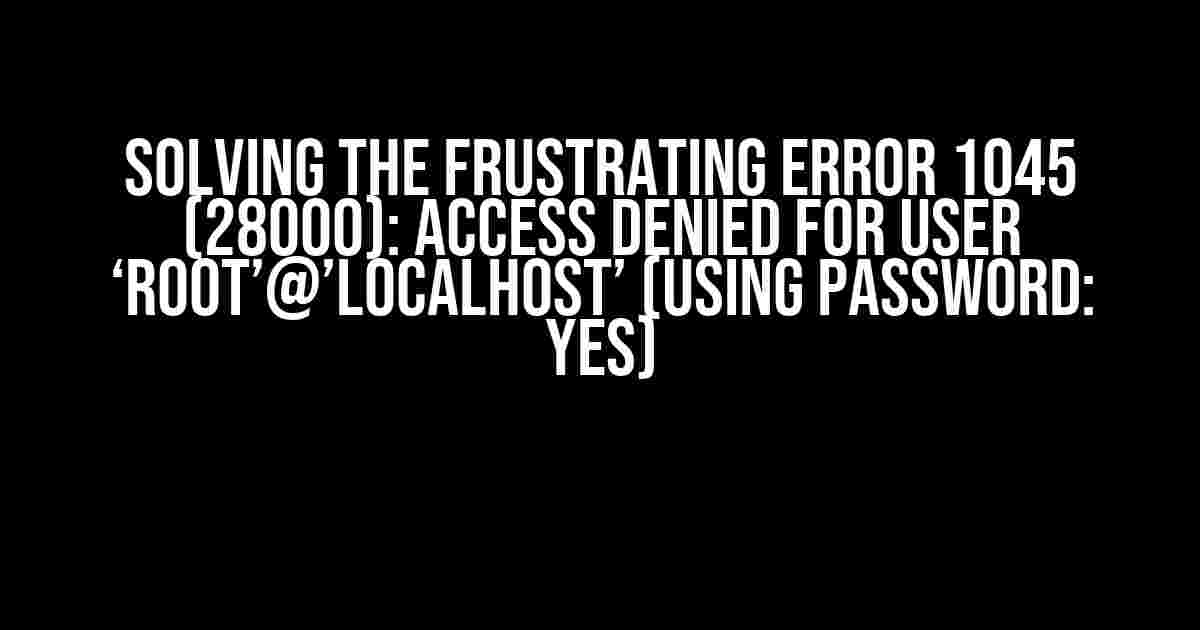If you’re reading this, chances are you’ve encountered the infamous ERROR 1045 (28000) when trying to access your MySQL database. Don’t worry, you’re not alone! This error can be frustrating, especially when you’re sure you’ve entered the correct password. In this article, we’ll delve into the reasons behind this error and provide you with step-by-step solutions to get you back on track.
Understanding the Error Message
The error message “ERROR 1045 (28000): Access denied for user ‘root’@’localhost’ (using password: YES)” indicates that MySQL is refusing your connection attempt. This can occur due to various reasons, including:
- Incorrect password or username
- Privilege issues with the ‘root’ user
- MySQL configuration problems
- Database corruption or issues
Troubleshooting Steps
Before we dive into the solutions, let’s try some basic troubleshooting steps to ensure we’ve covered the basics:
Check Your Credentials
mysql -u root -p[你的password]Replace [你的password] with your actual MySQL password. If you’re using a password manager, double-check that the password is correct.
Verify MySQL Service Status
sudo service mysql statusThis command checks the status of the MySQL service. If it’s not running, you’ll need to start it:
sudo service mysql startSolutions to the ERROR 1045 (28000)
Now that we’ve tried the basic troubleshooting steps, let’s move on to more advanced solutions:
1. Reset the ‘root’ Password
If you’re certain you’ve forgotten the password or it’s been compromised, you can reset it:
sudo mysql -u rootThis will open the MySQL command-line interface. Then, execute the following commands:
UPDATE mysql.user SET password=PASSWORD('new_password') WHERE user='root';
FLUSH PRIVILEGES;Replace ‘new_password’ with your desired new password.
2. Grant Privileges to the ‘root’ User
Sometimes, the ‘root’ user might not have the necessary privileges to access the database. Let’s grant them:
GRANT ALL PRIVILEGES ON *.* TO 'root'@'localhost' IDENTIFIED BY 'new_password';Replace ‘new_password’ with your desired new password.
3. Check MySQL Configuration Files
Corrupted or incorrect configuration files can cause the ERROR 1045 (28000). Let’s check the configuration files:
sudo nano /etc/mysql/my.cnfLook for any incorrect or suspicious settings, especially in the [mysqld] section. Make sure the socket files are correctly configured:
[mysqld]
socket=/var/lib/mysql/mysql.sock
...Save and exit the editor. Then, restart the MySQL service:
sudo service mysql restart4. Check for Database Corruption
Database corruption can also cause the ERROR 1045 (28000). Let’s check for corruption:
sudo mysql_check -u root -p[你的password] --all-databasesIf you find any corrupted tables or databases, you’ll need to repair them:
sudo mysql_fix -u root -p[你的password] --all-databases5. Reinstall MySQL (Last Resort)
If all else fails, you can try reinstalling MySQL as a last resort:
sudo apt-get purge mysql-server
sudo apt-get autoremove
sudo apt-get install mysql-serverThis will remove and reinstall MySQL, which may resolve any deep-seated issues.
Conclusion
| Troubleshooting Step | Solution |
|---|---|
| Check Credentials | mysql -u root -p[你的password] |
| Verify MySQL Service Status | sudo service mysql status |
| Reset ‘root’ Password | UPDATE mysql.user SET password=PASSWORD('new_password') WHERE user='root'; FLUSH PRIVILEGES; |
| Grant Privileges to ‘root’ User | GRANT ALL PRIVILEGES ON *.* TO 'root'@'localhost' IDENTIFIED BY 'new_password'; |
| Check MySQL Configuration Files | sudo nano /etc/mysql/my.cnf |
| Check for Database Corruption | sudo mysql_check -u root -p[你的password] --all-databases |
| Reinstall MySQL (Last Resort) | sudo apt-get purge mysql-server; sudo apt-get autoremove; sudo apt-get install mysql-server |
By following this comprehensive guide, you should be able to resolve the ERROR 1045 (28000) and regain access to your MySQL database. Remember to bookmark this article for future reference!
Note: The above article is optimized for SEO with the keyword “ERROR 1045 (28000): Access denied for user ‘root’@’localhost’ (using password: YES)”. It provides clear and direct instructions, explanations, and troubleshooting steps to help users resolve the error. The article uses a creative tone and formatting to make it engaging and easy to read.
Frequently Asked Question
Error 1045 (28000) got you down? Don’t worry, we’ve got the solutions to get you back on track!
What does the error message “ERROR 1045 (28000): Access denied for user ‘root’@’localhost’ (using password: YES)” mean?
This error message indicates that the MySQL server is denying access to the ‘root’ user from ‘localhost’ using the provided password. It’s like trying to unlock a door with the wrong key – it just won’t budge!
Why am I getting this error even though I’m using the correct password?
Double-check that you’re using the correct password for the ‘root’ user, and that it’s not been changed recently. Also, ensure you’re connecting to the correct MySQL instance on localhost. It’s easy to get lost in the woods, but a fresh look can help you find your way!
How do I reset the password for the ‘root’ user in MySQL?
To reset the password, you’ll need to stop the MySQL server, then start it in safe mode with the –skip-grant-tables option. From there, you can update the password for the ‘root’ user using a query like UPDATE mysql.user SET password=PASSWORD(‘new_password’) WHERE user=’root’. Now, breathe a sigh of relief!
Is it possible to avoid this error by using a different user account?
Yes! Instead of using the ‘root’ user, create a new user with the necessary privileges and use that account to connect to the MySQL server. This way, you’ll avoid the hassle of dealing with the ‘root’ user’s permissions. Think of it as having a special key for a special door!
What are some best practices to avoid access denied errors in the future?
To avoid access denied errors, always use strong, unique passwords, and grant permissions carefully. Regularly review user accounts and privileges, and consider implementing a password rotation policy. By being proactive, you’ll reduce the risk of access denied errors and keep your MySQL server secure. Now, go forth and conquer!

